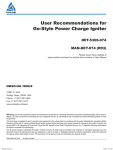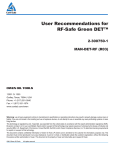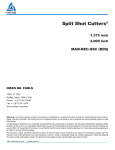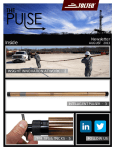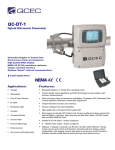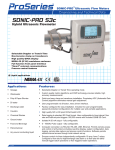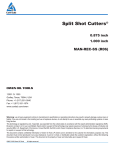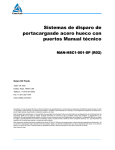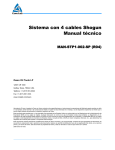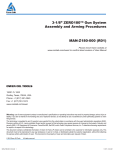Download DET-3050-321 O321 Detonators
Transcript
User Recommendations for O-321 Detonators DET-3050-321 MAN-DET-321 (R03) Please check Owen website at www.corelab.com/owen/ to confirm latest revision of User Manual 12001 Cr 1000 Godley, Texas, 76044, USA Phone: +1 (817) 551-0540 Fax: +1 (817) 551-1674 www.corelab.com/owen Warning: use of owen equipment contrary to manufacturer’s specifications or operating instructions may result in property damage, serious injury or fatality. If you are not trained in the handling and use of explosive devices, do not attempt to use or assemble any owen perforating systems or owen firing devices. This technology is regulated by and, if exported, was exported from the united states in accordance with the export administration regulations (EAR). Diversion contrary to U.S. Law is prohibited. Export and/or re-export of this technology may require issuance of a license by the bureau of industry and security (BIS), U.S. Department of Commerce. Consult the BIS, the EAR, and/or Owen Compliance Services, Inc. To determine licensing requirements for export or re-export of this technology. This document contains confidential information of Owen Oil Tools LP (Owen) and is furnished to the customer for information purposes only. This document must not be reproduced in any way whatsoever, in part or in whole, or distributed outside the customer organization, without first obtaining the express written authorization of owen. This document is the property of owen and returnable upon request of Owen. ©2015 Owen Oil Tools All rights reserved MAN-DET-321.indd 1 9/2/15 1:15 PM User Recommendations for O-321 Detonators TABLE OF CONTENTS SECTIONS: 1.0 Procedures for Panel Setup and Firing Resistorized Bridge Detonators.......................................................4 2.0-- Arming...........................................................................................................5 3.0-- Frequently Asked Questions.......................................................................7 2 I MAN-DET-321 (R03) MAN-DET-321.indd 2 ©2007, 2015 Owen Oil Tools All rights reserved 9/2/15 1:15 PM User Recommendations for O-321 Detonators Warning: Explosives are destructive by nature! Do not attempt to disassemble or alter the detonator in any manner! Do not crush, hammer, pinch, impact, pull wires, or abuse the detonator or any explosive. Warning: Be sure to follow safe operating practices as found in API RP-67 in accordance with governmental regulations, company policies, and manufacturer’s recommendations! Owen Oil Tools’ Resistorized Bridge Detonators are designed to detonate when an electrical current greater than 0.2 amps is applied. The O-321 Detonator is a resistorized electrical detonator manufactured to API RP-67 recommendations and employs a 51 Ohm resistor in the firing circuit. It is designed to be used in hollow steel carrier or scalloped gun systems where a fluid sensitive detonator will prevent the detonation of a “flooded” gun when used properly. Fluid migrating through the top fluid holes in the body of the detonator will desensitize the powder around the resistor and prevent the detonator from achieving a high order detonation. The O-321 detonator is intended to be used with 80 grains/foot round detonating cord in operating conditions up to 350° F for 1 hour while still maintaining its 99.99% initiation reliability @ 95% confidence. The following detonating cord types are compatible with the O-321 detonator: • 80 gr/ft PETN • 80 gr/ft HMX • 80 gr/ft HMX LS • 80 gr/ft RDX • 80 gr/ft RDX LS The user should satisfy themselves, as to the suitability of this product for the user’s application. Please refer to the Owen Oil Tools’ “Technical Specifications” sheet (Owen Document # DET-3050321-DS) for more information. ©2007, 2015 Owen Oil Tools All rights reserved MAN-DET-321.indd 3 MAN-DET-321 (R03) I 3 9/2/15 1:15 PM User Recommendations for O-321 Detonators 1.0 Procedures for Panel Setup and Firing Resistorized Bridge Detonators 1.1 Prior to arming or gun make up: • Measure the current output from the panel with a digital blasters multi-meter at the cablehead, CCL, or Quick-Change. Verify a minimum of 1.0 Amps output can be applied from the panel to the meter. 1.2 Reset panel to safe mode. 1.3 Continue proper assembly of toolstring. 1.4 When ready to fire a gun or detonator downhole, increase the power to the firing circuit from 0 to the 1.0 Amp rheostat position over 4-6 seconds until the detonator fires. Note: The user should see the current and voltage levels rise when power is applied. The current will “break” and go to 0 Amps when the detonator has fired. 4 I MAN-DET-321 (R03) MAN-DET-321.indd 4 ©2007, 2015 Owen Oil Tools All rights reserved 9/2/15 1:15 PM User Recommendations for O-321 Detonators 2.0Arming Warning: Detonators should be removed from their individual packaging and storage in the loading/arming area at the time of arming! Always insert the detonator inside a Safety Tube (P/N DET-2000-000) after removal from packaging and storage! Note: An electrical check of the detonator’s firing circuit may be 2.1 conducted while the detonator is confined within a safety tube. Using electrical blasters multi-meter with alligator clip leads, the O-321 resistorized bridge detonator will measure a resistance of 51 Ohms ± 2.5 Ohms Remove the O-321 detonator (Owen P/N DET-3050-321) from its packaging. The detonator will have a top sticker with the words “Remove Before Use”. REMOVE THIS STICKER! Remove this sticker ©2007, 2015 Owen Oil Tools All rights reserved MAN-DET-321.indd 5 Fluid Desensitization holes MAN-DET-321 (R03) I 5 9/2/15 1:15 PM User Recommendations for O-321 Detonators 2.2 Insert the detonator into a detonator safety tube (P/N DET-2000-000) and secure the lid shut. The resistance may be checked at this time. 2.3 Make sure the panel is safe, key is removed and outside the unit, and verify no voltage is measured on the wireline. 2.4 With the detonator still in the safety tube, electrically connect the detonator lead wires to the wireline cable. The detonator is now electrically armed, and may now be removed from the safety tube. 2.5 Carefully make a square, clean cut of the detonating cord using the Owen Super Cutters (P/N DET-0000-036). 2.6 Install the detonator onto the detonating cord by sliding the newly cut end of detonating cord through the detonator’s clip as shown in the below figure. Once the detonating cord is feed through the clip, cover the cut end of the detonating cord with tape prior to assembly into the port sub. This will prevent the detonating cord from sliding back through the clip. The detonator is now ballistically armed, and the finished product should look something like the figure below. 2.7 Ensure that the fluid holes on top of the detonator are not filled or covered by explosive powder, tape, etc. as this could prevent the detonator from being fluid sensitive. 2.8 Complete the mechanical assembly of the device and tool assembly while taking care not to force, pinch, crush, or impact the explosive components or wiring. 6 I MAN-DET-321 (R03) MAN-DET-321.indd 6 ©2007, 2015 Owen Oil Tools All rights reserved 9/2/15 1:15 PM User Recommendations for O-321 Detonators 3.0 Frequently Asked Questions 3.1 Can the O-321 detonator be used with ribbon or flat type detonating cord? • No, the O-321 detonator is not compatible with ribbon or flat detonating cord. This is due to the geometry of the detonating cord, which renders it unreliable in side initiating methods. Please reference pg. 2 of this User Manual for compatible detonating cord types. 3.2 Is the O-321 detonator interruptible? • No, the O-321 does not have the ability to be ballistically interrupted for armed transport. Please do not attempt to interrupt the detonator with custom alternative methods as this is not compliant with regulatory shipping regulations nor API RP-67. 3.3 What amperage will these detonators fire at? • The O-321 detonator has an “All-Fire” rating of up to 1.0 Amp. The nominal firing current level for the detonator is approximately 0.9 Amps. At elevated temperatures near 300oF or higher, the firing current level will decrease to approximately 0.7 Amps. Owen recommends that the user continue to apply power until a break in the current reading is observed. This break will indicate that the detonator has fired, and power can no longer be applied through the wireline. 3.4 Can the O-321 detonator be used in either positive or negative polarity? • Yes, the detonator may be attached to the wireline in either positive or negative polarity. The detonator’s functionality is independent of the flow of current (positive or negative) through the wireline 3.5 What resistance will the detonator measure? • When the detonator lead wires are attached to a Blaster’s Ohm Meter, the O-321 resistorized detonator will measure approximately 51 Ω. Always insert the detonator into a safety tube (Owen P/N DET-2000-000) when checking resistance! 3.6 Can I use this detonator with electronic addressable switches? • Yes, the O-321 detonator is compatible with most electronic addressable switches. Please consult your local Owen representative to receive more details before using the O-321 detonator with the electronic addressable switch. ©2007, 2015 Owen Oil Tools All rights reserved MAN-DET-321.indd 7 MAN-DET-321 (R03) I 7 9/2/15 1:15 PM







